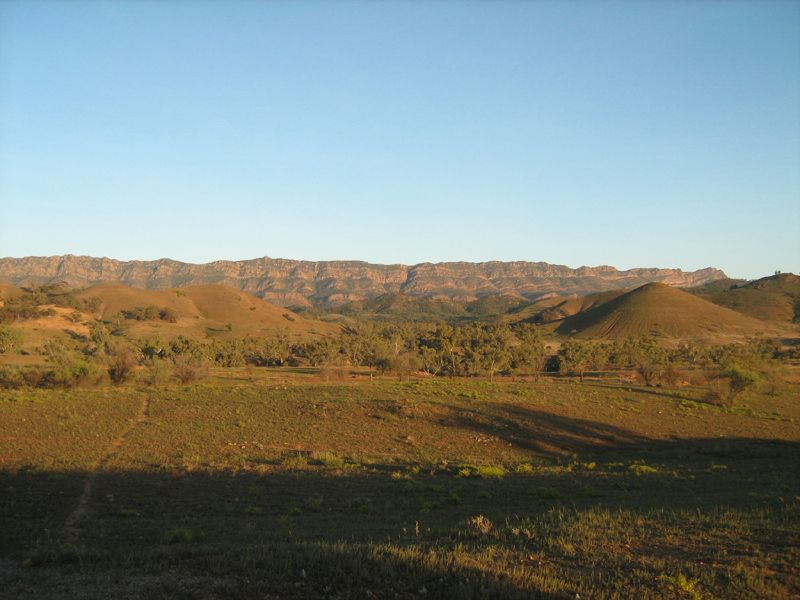
After driving for three days through the Mallee country of Victoria and into remote areas of South Australia, this is the view that we woke up to on our first morning in the Flinders Ranges. The green grass would be dry by now as this was the last week in September. The Flinders Ranges are the most spectacular colours and these photo's dont really show that. Flinders Blue Violet and Flinders Red Violet are familiar names to Australian Artists.The photo was taken between Hawker and Wilpena Pound. an natural amphitheater formation in the Flinders. What we did not expect on our first day there was that the temperature reached 38c!!! dry and dusty.
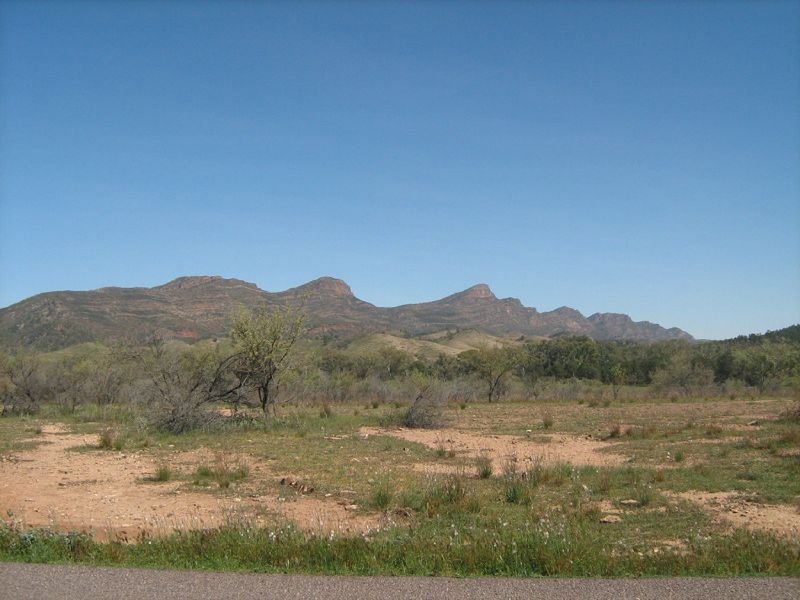
These rangers are the beginning of Wilpena Pound. The day became very windy, with a heat haze appearing across the entire landscape.
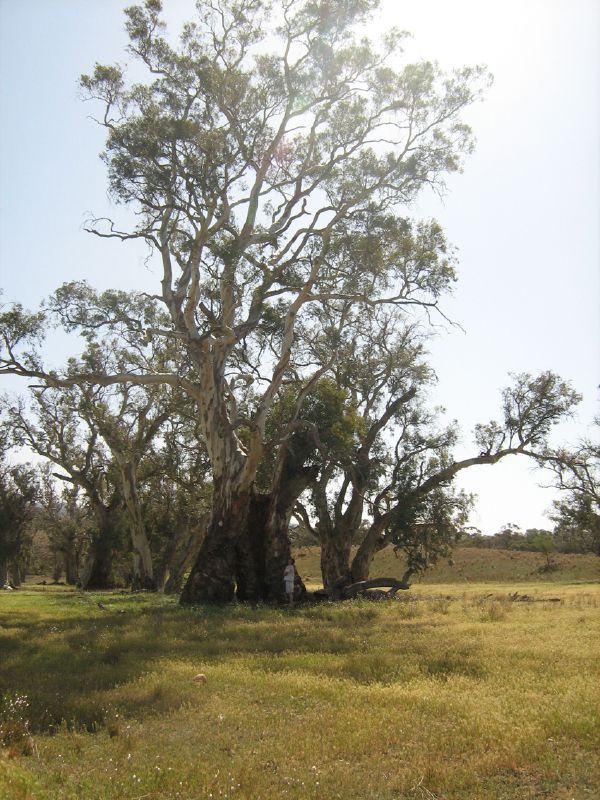
The Flinders Ranges are renowned for their redgum trees, made famous in the paintings of Hans Heysen.These trees are huge and majestic.Only growing in water courses,they follow the flow of the land. Gerard is six foot two and this tree towers over him.
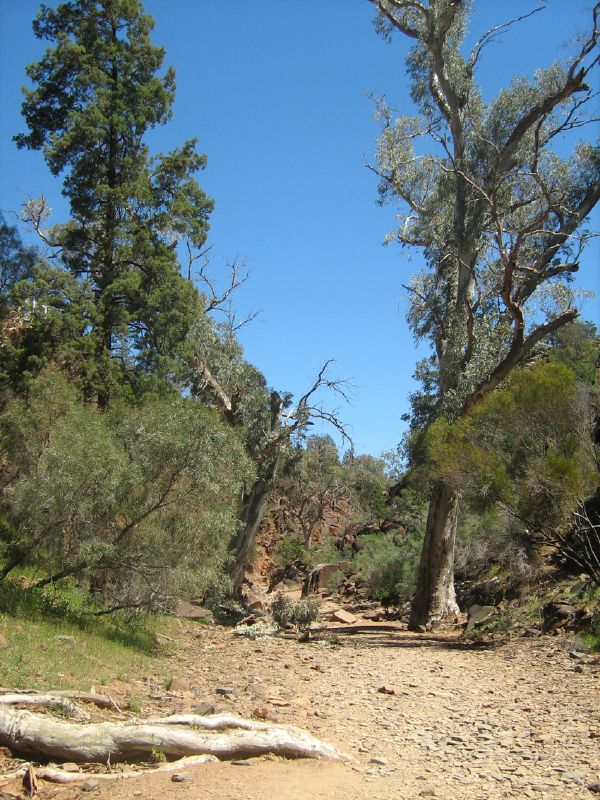
Sacred Canyon Aboriginal engraving site, begins with a walk along a dry creek bed lined with many redgum trees.
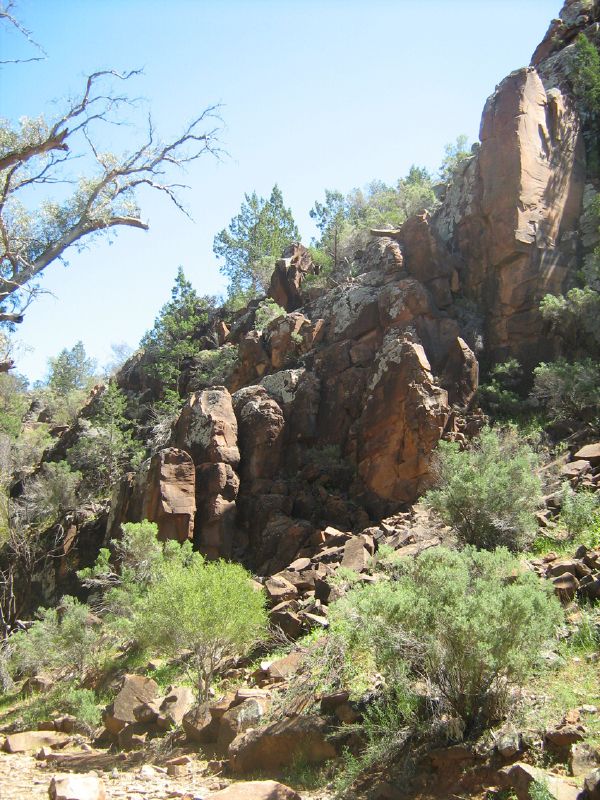
As you slowly enter the canyon you tend to get a sense of timelessness, nothing here has changed for centuries.

Aboriginal art of the Flindes Ranges in the form of engravings paintings and drawings is called Yura Marlka by the Adnyamathanha people of the Flinders Ranges. The Adnyamathanha people are a mix of the formerly distinct but related Walpi,Kuyani, JadlIaura Piladappa and Palanka groups. The name Adnyamathanha is a collective term now used by the groups and literally means hills people Anya-stone, hill-matha group.

Sacred Canyon is a significant site for the Adnyamathanha people and is protected through the Aboriginal Heritage Act 1988
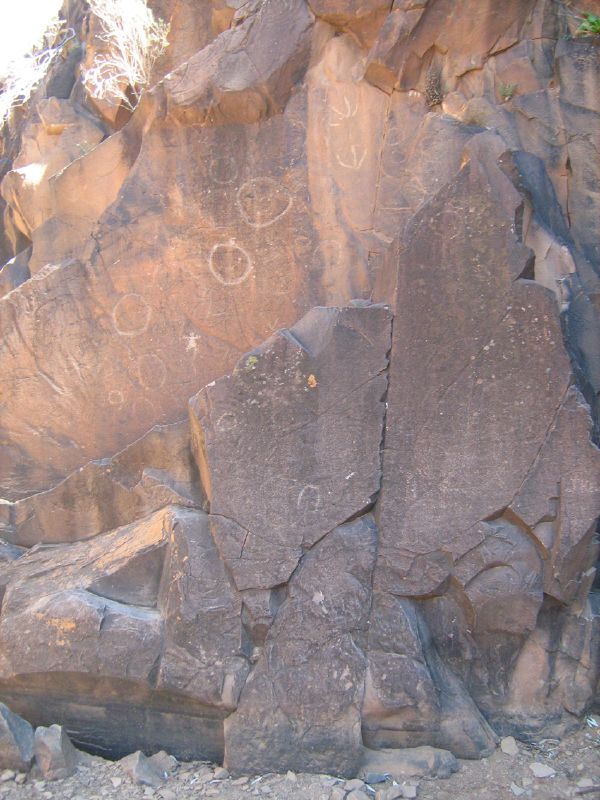
Aboriginal rock engravings are found throughout South Australia. They were produced by repeatedly hitting the surface of the rock with a sharp object to produce a series of interconnecting pits or by rubbing the rock surface with a sharp object to produce a groove. Common motifs in South Australia include geometric circles or linear designs or animal tracks. Animal and human figures can accompany these designs. As you walk through Sacred Canyon you can see many engravings, including motifs depicting animal tracks, geometric circles,and linear designs. You can see emu and kangaroo tracks among the engravings. The age of the engravings is unknown but the Adnyamathanha people believe that the engravings were not made by people but were created for them by ancestral beings during the Dreaming.
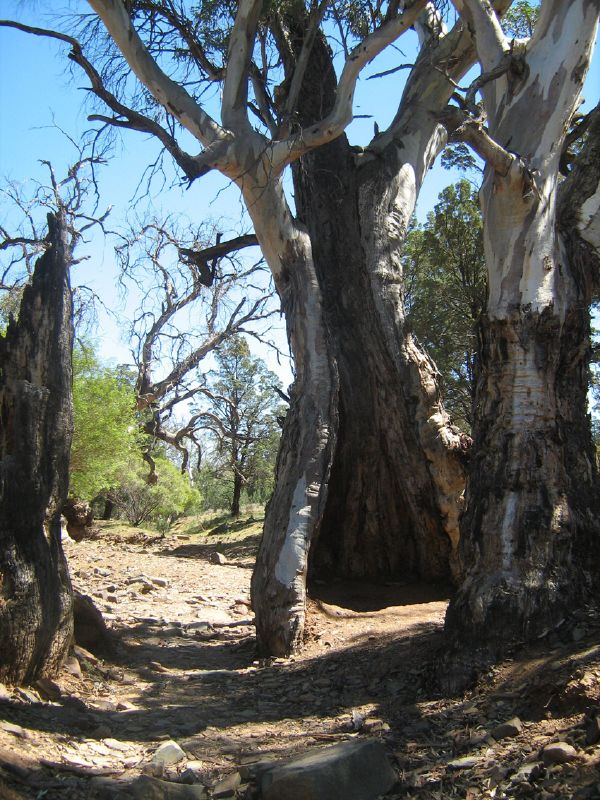
The canyon opens up again into a creek bed. This old tree has continued to pass through time even though it has been divided in half, many years ago.

It is amazing that the inside of the tree reflects the same colours as the land and canyon.

This photo was taken on the road from Sacred Canyon back to Wilpena on the second day that we were there. The day was a much more pleasant temperature of about 23c and no heat haze so as you can see the colour is more intense.
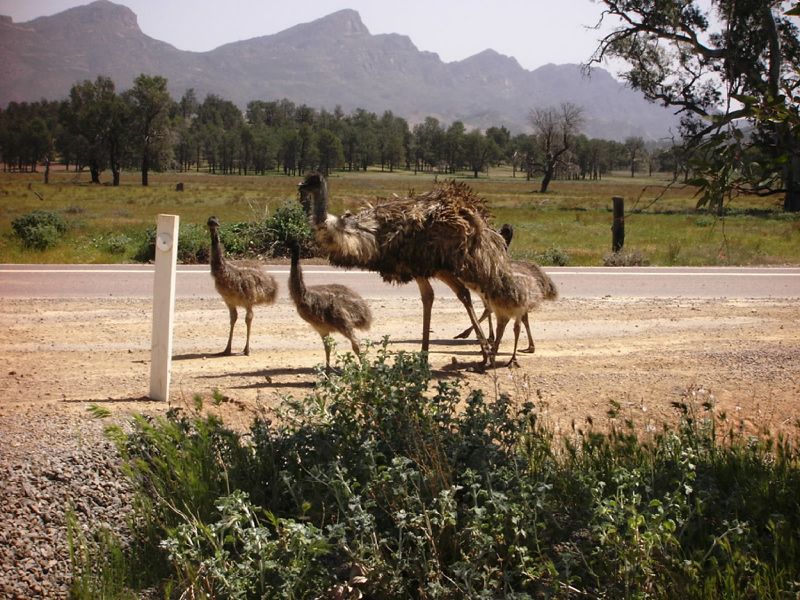
On the main road we came across a male emu with his young. Although we see many emu's here in the Grampians we stopped while Gerard took a video to show his students in China. During the time we were in the area there were many art exhibitions on. A wonderful historic wool shed housed a fabulous exhibition of Aboriginal Artist's work. We were very lucky that the exhibition was being looked after at the time by one of the artist's. My favorites were simple stories of the Dreaming, painted in local ocre which the area is renowned for. The colours were just beautiful, soft and quiet. Gerard and I spent about 1 hour talking with him, taking in the local stories. We left the Flinders to return to Hawker and then on to Quorn.

Yourambulla Caves Aboriginal Painting Site.
The name Yourambulla is derived from the Adnyamathanha phrase "yura billa", meaning two men, in the language of the Adnyamathanha people of the Flinders Ranges. Aboriginal paintings occur in caves, shelters and overhangs in the southern part of the Yappala hills. The age and purpose is not known but they are thought to relate to the Dreaming or ceremonies associated with the site.
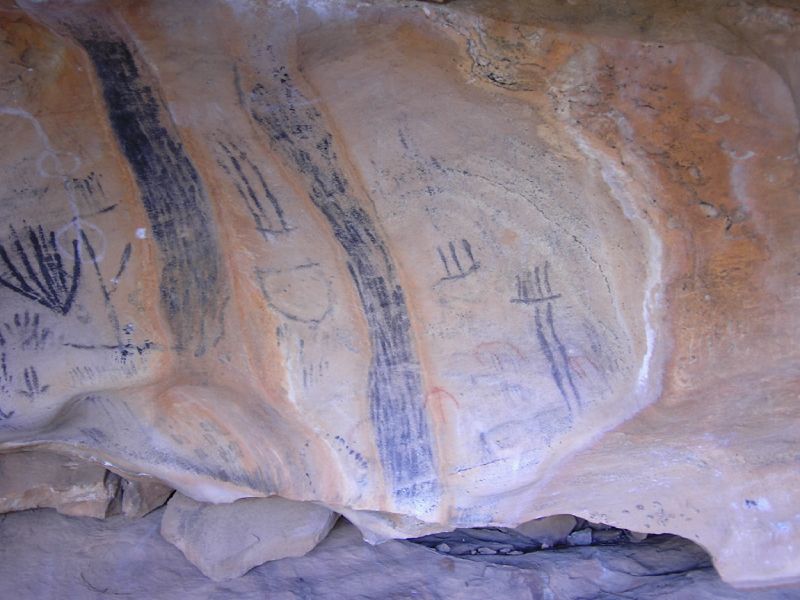
While the caves were probably visited regularly there is no evidence that they were inhabited. These caves and surrounding area form a large part of the Adnyamathanha peoples culture and heritage.
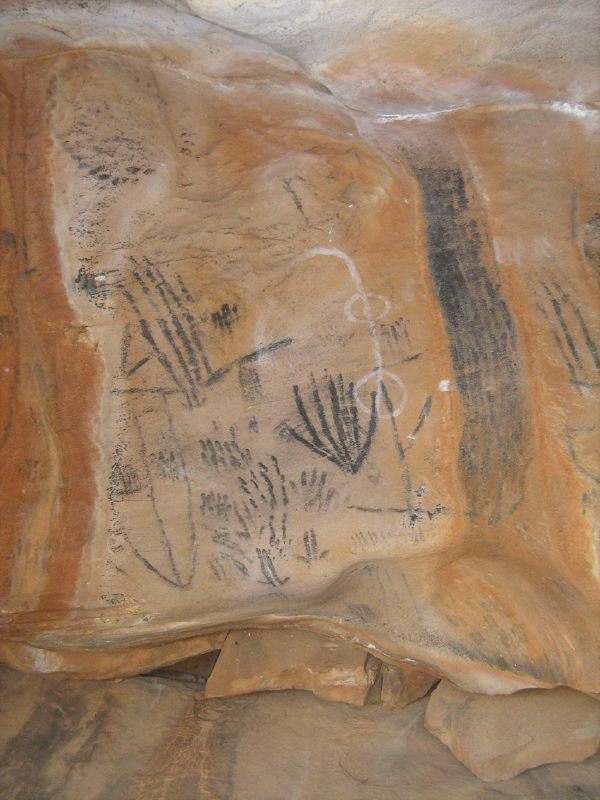
Yourambulla refers to the two peaks to the east of the caves which represent two ancestral companions who camped at this place while traveling in the Dreamtime or time of creation in Aboriginal mythology. This story describes how the Adnyamathanha moiety or kindship system came into being. This follows two matrilenial lines of decent, Arraru and Mathari.
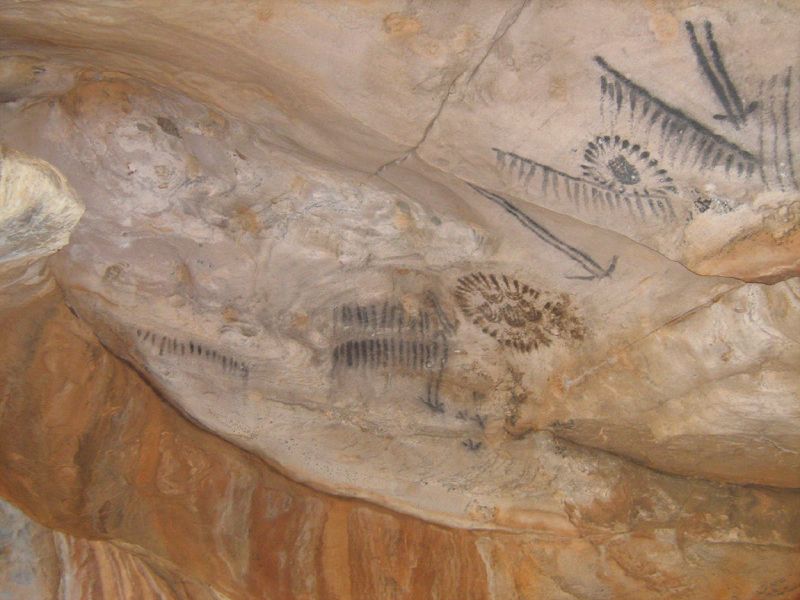
The description of the symbols here is too involved to tell but if anyone would like a detailed description feel free to email me and I will send it to you.
It was quite a walk to get to the caves although not difficult the last part was a series of very steep steps although they were more like climbing ladders, the site was very high up the rockface.
The drive between Quorn and the main highway to Port Augusta is one of my favorite parts of the Flinders as the road cuts many times between the hills. An historic steam train runs between Quorn and Port Augusta during holiday time. After driving through the Barossa Valley, a few relaxing days were spent with family in Adelaide. A pleasant day spent at the Art Gallery of South Australia where my favorite tapestry in the whole world hangs, the Adoration of the Magi by William Morris. While we were in the Flinders Ranges I celebrated my 49th birthday. Gerard bought me the cataloge from the Met Tapestry in the Renaissance: Art and Magnificence Although not my favorite period of historical tapestry the cataloge is fantastic and welcome addition to my library, a perfect birthday present. The five hour drive home from Adelaide showed how much the countryside had changed with the spring flush. The blossom of my crabapple trees welcomed us home along with the growth of weeds. We had a great time while we were away and Gerard left for China a few days after we returned to teach English at a University in Huainan for a few months, his second time there this year. If you would like to see some fantastic photo's taken by others of the Flinders Ranges click here.
SBS television here in Australia has produced a new seven part series called The First Australians.
The program begins with the first white settlers......our shame full past alas...
Seven years in the making with much never before seen footage the program will have you on the edge of your seat.
You can download the programs from this website for free, the day after they are aired. here in mp 4 format
I would encourage anyone with and interest in Aboriginal Culture to visit the website The First Australians
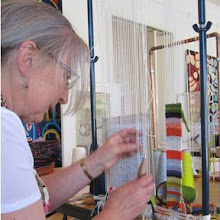


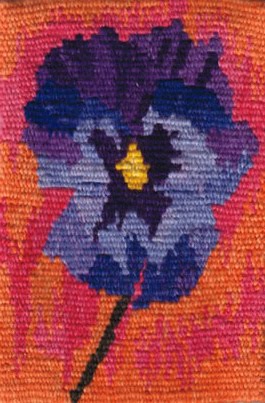



A am a big fan of rocks and trees, which are abundant where I live, too. But the ones there are amazing! We don't have emu in Colorado, either. Thanks for taking me on a great escape to your part of the world!
ReplyDeleteHi Kathy, The Flinders Ranges are a spectacular part of South Australia but very remote and not inhabited by many people. I am glad you enjoyed the photos. Debbie
ReplyDelete